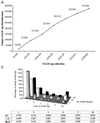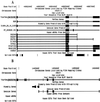Identifying novel transcripts and novel genes in the human genome by using novel SAGE tags
- PMID: 12213963
- PMCID: PMC129432
- DOI: 10.1073/pnas.192436499
Identifying novel transcripts and novel genes in the human genome by using novel SAGE tags
Abstract
The number of genes in the human genome is still a controversial issue. Whereas most of the genes in the human genome are said to have been physically or computationally identified, many short cDNA sequences identified as tags by use of serial analysis of gene expression (SAGE) do not match these genes. By performing experimental verification of more than 1,000 SAGE tags and analyzing 4,285,923 SAGE tags of human origin in the current SAGE database, we examined the nature of the unmatched SAGE tags. Our study shows that most of the unmatched SAGE tags are truly novel SAGE tags that originated from novel transcripts not yet identified in the human genome, including alternatively spliced transcripts from known genes and potential novel genes. Our study indicates that by using novel SAGE tags as probes, we should be able to identify efficiently many novel transcripts/novel genes in the human genome that are difficult to identify by conventional methods.
Figures


References
-
- Lander E. S., Linton, L. M., Birren, B., Nusbaum, C., Zody, M. C., Baldwin, J., Devon, K., Dewar, K., Doyle, M., FitzHugh, W., et al. (2001) Nature (London) 409, 860-921. - PubMed
-
- Venter J. C., Adams, M. D., Myers, E. W., Li, P. W., Mural, R. J., Sutton, G. G., Smith, H. O., Yandell, M., Evans, C. A., Holt, R. A., et al. (2001) Science 291, 1304-1351. - PubMed
-
- Hogenesch J. B., Ching, K. A., Batalov, S., Su, A. I., Walker, J. R., Zhou, Y., Kay, S. A., Schultz, P. G. & Cooke, M. P. (2001) Cell 106, 413-415. - PubMed
-
- Kapranov P., Cawley, , Simon, E., Drenkow, J., Bekiranov, S., Strausberg, R. L., Fodor, S. P. A. & Gingeras, T. R. (2002) Science 296, 916-919. - PubMed
-
- Adams M. D., Kelley, J. M., Gocayne, J. D., Dubnick, M., Polymeropoulos, M. H., Xiao, H., Merril, C. R., Wu, A., Olde, B., Moreno, R. F., et al. (1991) Science 252, 1651-1656. - PubMed
Publication types
MeSH terms
Substances
Associated data
- Actions
- Actions
- Actions
- Actions
- Actions
- Actions
- Actions
- Actions
- Actions
- Actions
- Actions
- Actions
- Actions
- Actions
- Actions
- Actions
- Actions
- Actions
- Actions
- Actions
- Actions
- Actions
Grants and funding
LinkOut - more resources
Full Text Sources
Other Literature Sources

